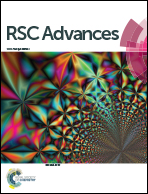Magneto-dielectric and magnetoelectric anisotropies of CoFe2O4/Bi5Ti3FeO15 bilayer composite heterostructural films
Abstract
Bilayer composite heterostructural films consisting of magnetic CoFe2O4 and multiferroic Bi5Ti3FeO15 films were prepared by the chemical solution deposition method. Morphological, ferroelectric, piezoelectric, magnetic, magneto-dielectric and magnetoelectric properties were investigated for CoFe2O4/Bi5Ti3FeO15 composite films. The magneto-dielectric and magnetoelectric effects are observed for the composite films, which is attributed to the enhanced interface coupling and mechanical strain transfer due to the small lattice mismatch between CoFe2O4 and Bi5Ti3FeO15 film layers. Magneto-dielectric and magnetoelectric anisotropies were also observed for the composite films. Correspondingly, the in-plane and out-of-plane magnetoelectric voltage coefficients reach 57 mV cm−1 Oe−1 and 78.9 mV cm−1 Oe−1, respectively. Thus magneto-dielectric and magnetoelectric anisotropies originate from the magnetic anisotropy of CoFe2O4/Bi5Ti3FeO15 composite films. The present work provides promising candidates for applications in magnetoelectric devices.


 Please wait while we load your content...
Please wait while we load your content...